|
Obsolete Outboards |

|
|
by Max Wawrzyniak - St Louis, Missouri - USA
Bringing
a 1956 Johnson 15 hp Back to Life
Part
1 |
 |
Part
2 - Part 3 - Part
4 - Part 5 - Part
6 - Part
7
Well, it's Spring time and the time of year that all young men
turn to thoughts of Messabouts and Antique Outboard Motor
Meets. And I decided that this would be the year that I pulled
the 1948 aluminum Feathercraft boat down out of the rafters of
the garage (where it has been for about 7 years) and actually
got it into the water.
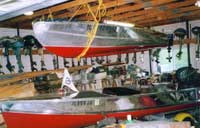 The 1948 aluminum Feathercraft boat has been hanging
from those rafters for several years. At only about 11 feet in length
and less than 4 feet wide, 15 hp ought to be plenty for the
little boat. The 1948 aluminum Feathercraft boat has been hanging
from those rafters for several years. At only about 11 feet in length
and less than 4 feet wide, 15 hp ought to be plenty for the
little boat.
(click images for larger views) |
|
Since it would need an engine, I went to the storage shed to see
what I had that was suitable, and eventually selected a 1956 Johnson
15 hp that I have owned for an equally long time, but have never done
anything with. And so begins the 3rd "Start to Finish" saga, where I
take an old outboard from "as-found" condition to "running " (I
hope) condition.
Since I had used a 5 1/2 hp outboard in the first "Start to Finish"
series of columns, and a 25 hp in the second "Start to Finish"
series of columns, I decided that the 15 would be a good choice,
if for no other reason than it splits the difference in horsepower
between the other (2) engines. Sort of like Goldilocks and the
three Bears. "Just right."
| 1956 was a good year for outboard motors. More outboards
were sold in 1956 than in any year before or since. Sterndrive
boats did not exist in 1956, but even if sterndrive sales figures
are included with outboard motor sales, today's unit sales still
don't come close to 1956. |
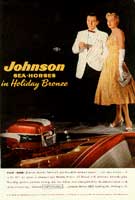
|
|
The 15 hp Evinrude made its first appearance in 1953 but a Johnson
version was not available until 1956. The 1953 & 1954 Evinrude
15's are about the lightest 15's around, even when compared to
modern 15's, but without sound proofing or vibration-absorbing
mounts they are not the smoothest or quietest outboards around.
The 1955 Evinrude 15 was a more civilized engine which featured
improved sound and vibration control and a much-improved tilt
adjustment mechanism. The only fault I can find with the '55 15 is
a somewaht weak recoil starter housing. Most recoil starter damage,
however, is due to operator error. The correct way to use any recoil
starter is to slowly pull the starter handle until the starter is felt to
engage the flywheel, then give a firm, brisk pull. What many people
do is grab the handle and give it a hard jerk which causes the
recoil starter to slam into engagement with the flywheel. Eventually,
something breaks.
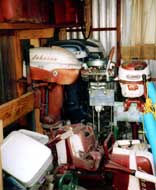 |
The 1956 Johnson 15 hp, looking a bit faded and worn, has been sitting on the rack in my storage shed for years. Time to dust off the cob webs and mud dauber nests and put the old engine to work.
|
|
The 1956 15 was the final refinement of the Evinrude (and now Johnson)
15, featuring an improved recoil starter design and a flywheel modified
to prevent gasoline vapors from entering the magneto and possibly
causing a minor explosion (a somewhat remote possibility, in my
opinion). In 1957, the cylinder bore of the 15 was
increased and the horsepower was upped to 18, and 18's continued
to be produced up until the early '70s.
The 15's (and the subsequent 18's) are just about the largest outboards
that one can (somewhat) comfortably carry and mount on a boat. They
provide plenty of power for the size boats that most of you guys build
(a 1957 18 is the engine I use most often on my Jim Michalak-designed
AF4). And finally there were many of these engines sold during the
'50s and '60s and they are not too difficult to find.
| The Gale 15's from the early '60s are virtually identical to the 1956 Johnson
15 except for cosmetic details. For that matter, the Johnson and Evinrude
18's that supplanted the 15's are also virtually identical except for cosmetic
details and cylinder bore diameter. |
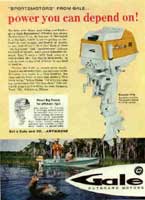
|
|
Although this series of columns concerns the 1956 15, all of the information
is applicable to the later 18 hp models which were almost mechanically
identical to the '56 15. The Gale 15's (see Gale Warnings column) can
also be included, as can the 10 hp models of the '50s and early '60s.
All of these engines utilize the same ignition components, the same
carburetor rebuild kit, the same water pump impeller and the same
recoil starter spring. As a collector of old outboards, I tend to prefer
the styling of the older versions, but the same basic engine resides
under the more modern cowls and paint schemes of the models
of the '60s.
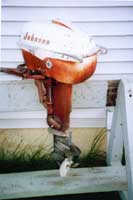 |
Pretty scruffy looking, but the plan is to re-paint once the engine is in running condition.
|
|
Once I had the 15 out of the storage shed and brushed-off the obvious
mud dauber nests, I gave the starter rope a pull to ensure that the engine
was not "frozen" or "locked-up" (i.e. that the pistons were not siezed in the
cylinders) and also to get an idea of the compression of the engine.
An engine that has seen many hours of use, or that has been run with
too little oil mixed in with the gasoline, or that has piston rings stuck in
their grooves from carbon build-up is not going to have much compression.
The proper way to check compression is with a compression gauge.
What I do is firmly pull the starter rope and listen and feel for a solid-sounding
"thunk-thunk" from the two cylinders. No very scientific nor an always reliable
method of checking compression, but then I live dangerously. Anyway, the
'56 has a decent-feeling thunk-thunk.
| Obviously this engine has spent a lot of time sitting on a boat in the water, and the former owner(s) neglected to tilt the motor out of the water when it was not being used. The original paint is completely gone and the aluminum castings show a bit of pitting. |
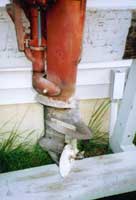
|
|
A visual check of the outboard revealed no missing parts; all of the knobs
and controls where in place. There appeared to be no obvious damage
such as broken castings. The paint and decals were in a horrible state.
Evidently this outboard had been left outdoors for extended periods of time,
and the brownish-red "Holiday Bronze" paint as completely faded away
in many areas, leaving few traces on the white undercoating. The decals
were "toast." I was not overly concerned with the paint and decals, however,
as I intended to repaint the motor anyway, and I would much prefer to repaint
a lousy-looking engine than one that was pretty-good looking.
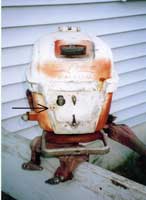 |
The mud daubers love old outboards. Although they usually prefer to build their nests under the hood somwhere, this old engine even has a nest on the control panel.
|
|
One aspect of the outboard's conditiion that stood-out was the lower unit.
It appeared that the motor had been left on a boat in the water with the motor
tilted down much of the time; the lower unit showed signs of long-term
immersion. The possible results of this abuse are corroded fasteners,
corroded shafts and gears caused by the long-term presence of water
in the lower unit oil, and even corroded castings. While not a good omen,
I decided that the outboard was still worth trying to bring back to life.
Next month will cover removal of the lower unit
for replacement of the waterpump impeller.
... on
to Part 2...

click here for a list of Columns by Max Wawrzyniak
|